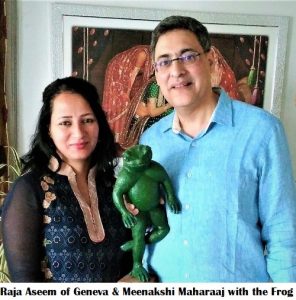50 years ago, Vern Nelson, owner of Bass Point Resort, caught a ‘giant frog’ in Lake Geneva. The 15- inch specimen weighed 17 ounces. This species had been brought to this area from Michigan by an American diplomat, it is said. Frogs range in size from the recently discovered 7.7-millimetre (0.30 – inch) of Papua New Guinea.
Scientists have found frogs fossils that date back to the Jurassic period over 140 million years ago. Frogs are valued as food by humans and also have many cultural roles in literature, symbolism and religion. In human cultures, featured through ages in the form of poetry, songs or stories; frogs are found all over the world, and in every climate, except Antarctica.
Frogs are amphibians, which comes from the Greek language and means “both lives.” Most frogs are born in water as tadpoles and gradually change into frogs .This allows them to be born and live far away from water, even on mountaintops.
There are approximately 4800 species of frogs around the world. They can be found near any, and every, body of fresh water but prefer ponds, lakes, and marshes, because the water doesn’t move very fast.
They are however, the most cosmopolitan. At the Frog Museum in the small medieval town of Estavayer-le-Lac, Switzerland, renowned for being one of the most beautiful protected natural sites, stuffed frogs depict the multiple Froggy scenes, in a 150-year old collection of domestic life in the 19th century.
Walking in the streets of Old Geneva town I saw varied figurines of frogs on sale. I was impressed by their colourful displays and in fact was lured to buy all the variants in designs and styles. I was inspired to model ‘frog camouflage’. Meenakshi did the colours.
I was also reminded of the Italian scientist, Luigi Aloisio Galvani’s discovery of Animal electricity in 1780 by observing the signals from tissues of the nerves and muscles of dead frogs’ legs. With each flash of lightning, the frog’s legs twitched and jumped as if they were alive.
Back home my wife , Doctor Vishav Kirti , was reminded of the frog dissection as a biology student in G G M Science college, Jammu. “A frog has a spine. Humans are also vertebrates. By studying the anatomy of a frog ,we can learn about our own anatomy” she said. “Both man and the frog have the same kinds of organs and systems of organs. The frog has a highly developed nervous system. The important parts of the frog brain correspond to comparable parts in the human brain.”
- Frogs use camouflage to avoid predators while they sleep, call and feed. Are colored to match the surroundings.
- No teeth are in the lower jaw and frogs usually swallow their food whole.
- True toads completely lack teeth, but most frogs have them, these are on the edge of the upper jaw.
- The teeth are mainly used to grip the prey and keep it in place till swallowed, a process assisted by retracting the eyes into the head.
- Its lungs are similar to those of humans, but the chest muscles are not involved in respiration, and no ribs or diaphragm exist to help move air in and out. Instead, it puffs out its throat and draws air in through the nostrils.
- Frogs have three eyelid membranes: one is transparent to protect the eyes underwater, and two vary from translucent to opaque.
- The structure of the feet and legs varies greatly among frog species, depending in part on whether they live primarily on the ground, in water, in trees or in burrows.
- Aquatic frogs are likely to have long, strong legs with webbed back feet to help them swim.
- Frogs that live on land tend to have shorter legs for walking and climbing.
- The skin hangs loosely on the body; is permeable to oxygen and carbon dioxide, as well as to water.
- The thin, porous skin of frogs and tadpoles makes them sensitive creatures.
- Frogs breathe through their skin and through this skin they absorb chemicals from the air and water.
- Frogs don’t need to drink the way we do: they absorb water through their permeable skin!
- There are blood vessels near the surface of the skin and when a frog is underwater, oxygen diffuses directly into the blood.
- Frogs cannot live in the sea or any salt water. Some frogs have no tongue and just stuff food into their mouths with their hands.
- The eyes assist in the swallowing of food as they can be retracted through holes in the skull and help push food down the throat.
- Frogs have no tail, except as larvae, and most have long hind legs, elongated ankle bones, webbed toes, no claws, large eyes, and a smooth or warty skin.
- They have a tympanum on each side of their heads which is involved in hearing and, in some species, is covered by skin.
- In almost all frogs, egg fertilization happens outside the female’s body instead of inside.
- The female releases her eggs and the male releases his sperm at the same time. In order to make sure that the sperm reach the eggs, the male and female get into a mating posture.
- Frogs and toads produce a rich variety of sounds, calls, and songs during their courtship and mating rituals. The callers, usually males, make stereotyped sounds in order to advertise their location, their mating readiness and their willingness to defend their territory; listeners respond to the calls by return calling, by approach, and by going silent.
Amphibians have been a good food source. It is conservatively estimated that humans consume up to 3.2 billion frogs for food around the world every year.
Frog legs are one of the better-known delicacies of French and Chinese cuisine. Frog legs are rich in protein, omega-3 fatty acids, vitamin A, and potassium. The taste and texture of frog meat is approximately between chicken and fish.
Geneva is well known for the quality and diversity of its restaurants and given its proximity to the French border, it is hardly surprising that it boasts such a large number of authentic French establishments. From frogs legs to snails the stylishly presented dishes are influenced by France but draw on top quality Swiss seasonal produce.
Frog meat is considered as haraam (non-halal) according to mainstream Islamic dietary laws.
Many environmentalists urge the restriction of frog consumption—especially those harvested from the wild—because amphibian populations are declining and frogs are an essential element of ecosystems. To avoid the complete disappearance of the species in some countries, the capture of frogs has been completely banned or strictly controlled. A few years ago India dominated in frog leg export , it is banned since 1987. In many parts of Kerala, especially Central Kerala, frog legs are a delicacy.
Frogs are an important part of our environment for many reasons, not least because:
- Due to high degree of sensitivity, either during tadpole stage or as adults, they respond to very slight change in the environment.
- More importantly, frogs are a good indicator of environmental damage.
- A frog mainly lives on insects and small animals like earthworms, minnows and spiders.
- Frogs provide insight into the health of the ecosystem.
- Frogs serve as food for birds, fish and mammals.
- Their tadpoles filter our drinking water.
- Frogs are sensitive to environmental changes, disease, habitat degradation, and pollution.
Frog populations have been declining worldwide at unprecedented rates, and nearly one-third of the world’s amphibian species are threatened with extinction.
Up to 200 species have completely disappeared since 1980, and this is NOT normal; amphibians naturally go extinct at a rate of only about one species every 500 years.
Amphibian populations are faced with an array of environmental problems, including pollution of our waterways, loss of habitation, invasive species, and climate change. One of the major culprits in any household is the cleaning materials we use; dish-washing and laundry products, toilet cleaners and a host of other cleaning products we use in our homes.Decline or extinction of their population has significant impact on other organisms along with them.
Because of their importance in ecosystem, according to ProNatura, a Swiss environmental organization, throughout Switzerland, temporary barriers are installed to prevent the amphibians from crossing the roads, lest they are crushed.
Though, during my walks in Varsoa, I did not come across any such barrier.
Frogs rarely breed in captivity that is the basic problem.
Unless we act quickly, amphibian species will continue to disappear, resulting in irreversible consequences to the planet’s ecosystems – and ultimately to us humans.
Prof. (Er.) Chander P Mahajan is an art critic & a free lance journalist. The Environmentalist stays in Shimla and Dalhousie, Himachal Pradesh, India.








